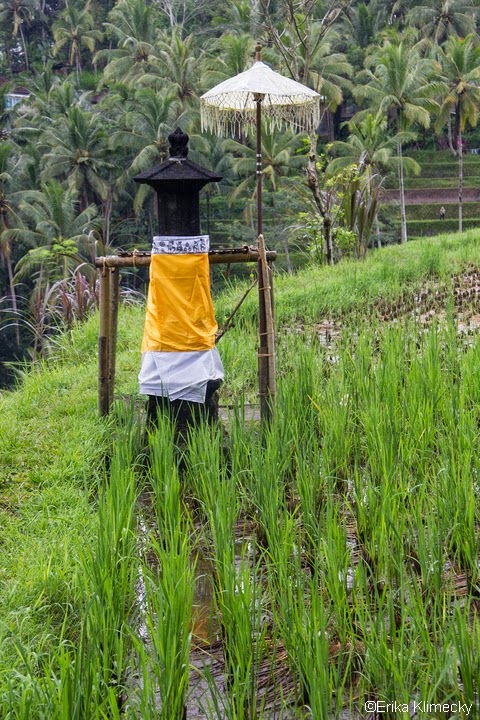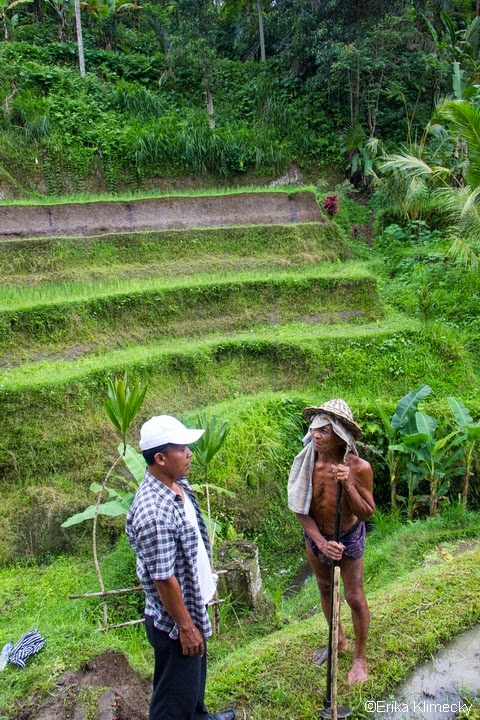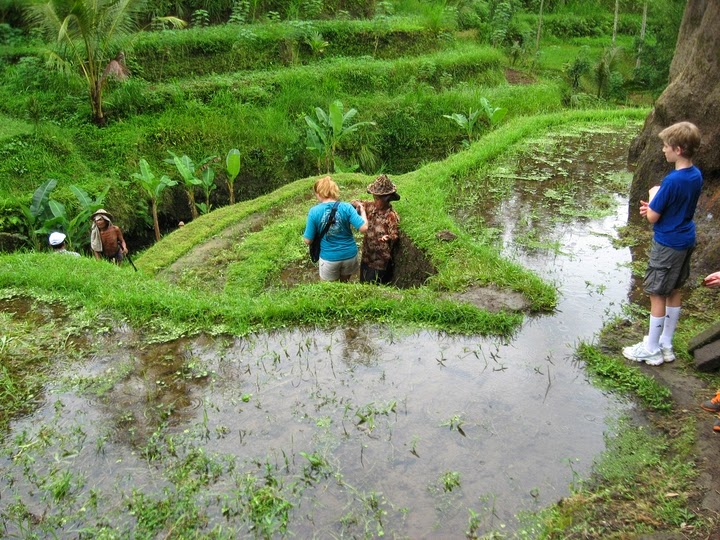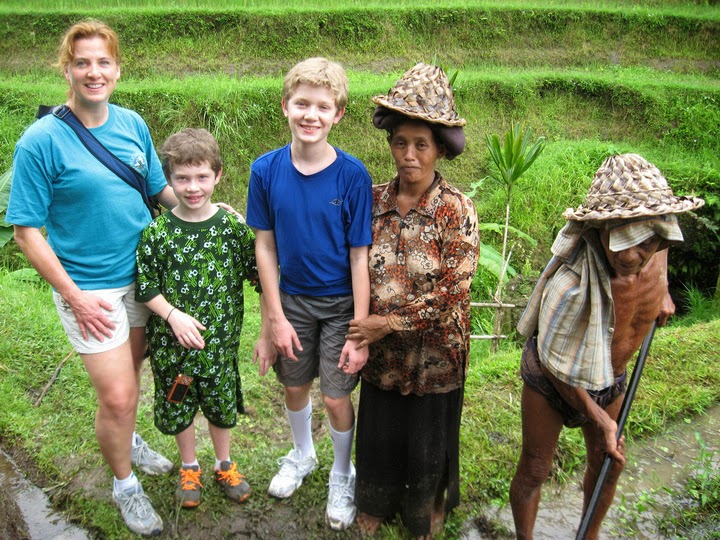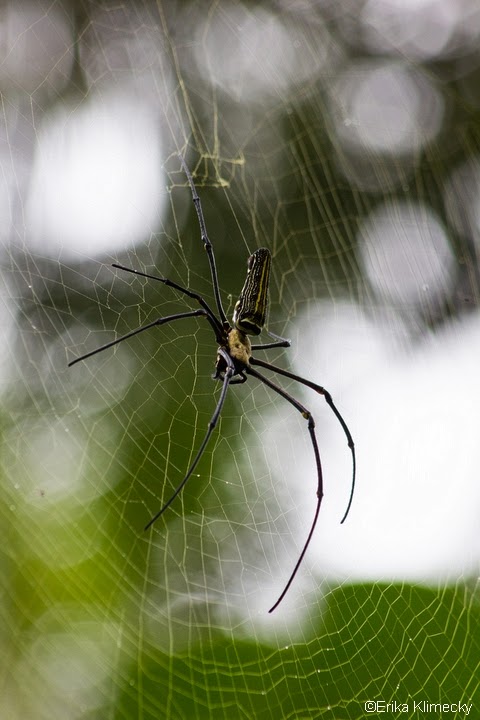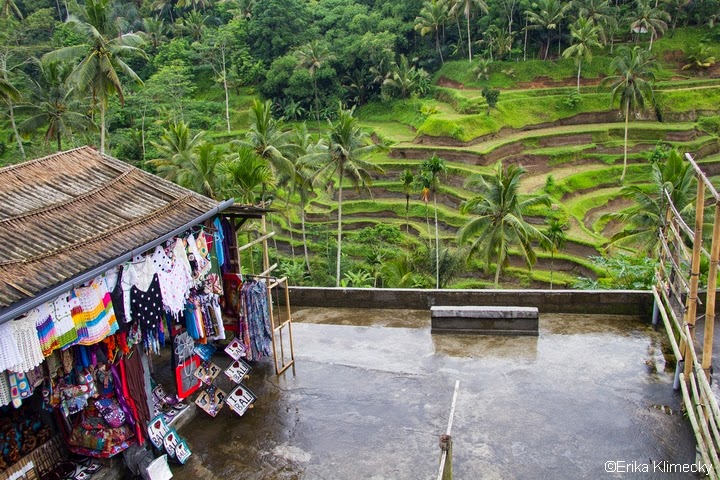Active Mind, Creative Spirit
Bali Rice Hike
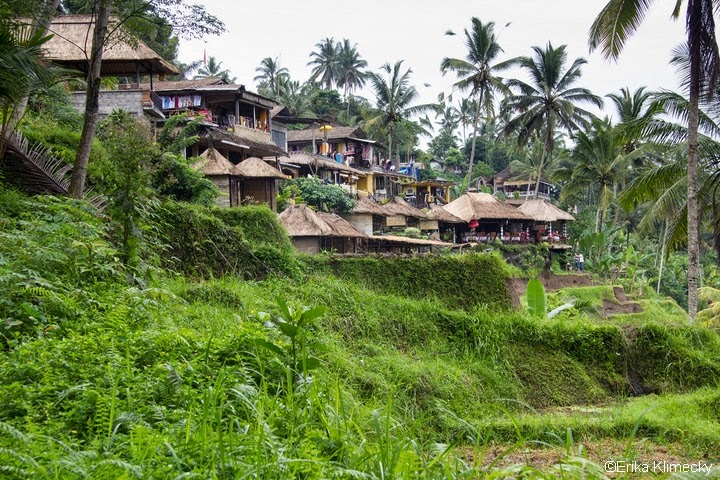
I still don’t know if this is something that only I love, or if it strikes most people, how beautiful and essential rice fields are. I’ve gone on about it in a past post, so this is the photo tour of the rice hike we did in Bali. Our guide, Wayan took us to a small village outside the cultural center of Ubud where we parked on the street and were immediately accosted by 8-year old girls selling post cards.
Okay, so it’s not that far off the beaten path. Bali, when compared to the other Indonesian islands, is a tourist mecca, with its proximity to Australia, party-accommodating flavor and hotel-filled city. It’s a two-hour flight from Darwin, so it’s an easy choice for spring breakers and families looking for a weekend escape from Down Under. While the city of Denpasar succeeds in containing most of the weekend warriors and college craziness, the villages out of town offer a look at things like this.
Take a walk with me. [Click the photos to see them in theater, large]
The village
This is one of the farmers who let us walk through his rice fields. He’s also a woven-palm-frond-hat salesman on the side. Have one?
Down a steep, muddy trail, we rounded a corner and began walking among the paddies. This must be his resting shed or a storage hut. It’s away from all the village buildings, right in the middle of a hillside…. and not far from a bridge.
The bridge we crossed to get across the ravine between the village and the paddies. All hand cut bamboo and lashing… and nothing else. Happy family at the other side.
I love this image because it shows how big each of the terraces are. We walked up the sides of these to get between the levels. Occasionally a ladder is lashed in place (handmade bamboo, of course) but usually you just hoof it up and hope it’s not too slippery. She’s clearing weeds from the sides here, to keep them out of the paddies. Imagine the job this is, with the tropical, equatorial weather and moist volcanic earth. Taro and banana tree in the foreground, growing between the edges of the paddies, and the colored fabric on poles are makeshift scarecrows.
This is another look at the vastness of the vertical farmland (don’t miss the person for scale). A far cry from the Great Plains farmland I grew up on.
This is a shrine. They are sprinkled randomly across (or in the middle of) the paddies to please the gods. Offerings are left on the platform below the parasol.
This one I love for the undulating, organic shapes of the land. It truly feels like a place where man and nature have come to a perfect compromise. Yes, the farm works, but no way are there straight rows or easy access. Hand tools only, no machines. The terrace heights and shapes are dictated by the mountain they are built on. Seemingly random red flowers add so much. Foot and tool paths in the mud of the foreground. Note here, that 100 square meters of fields yield 50 kilos of rice, three times a year. The average Bali resident eats 1 cup uncooked per day.
Then on to the next farmer’s paddies. He and his wife seemed to be expecting us. Wayan, our guide, kindly announced our presence and softened our encroachment on their farm.
She dropped her hand tool and ran to help me down the steep, muddy bank. Already barefoot, she stepped into the paddy beside the path, and sank in calf-deep while positioning herself. Then she stepped up on the hillside and braced her tiny, sinewy frame to help me down, all the while issuing commands in mostly Balinese.
The rest of the family received the same cordial treatment.
In writing this post, I paused here because my memory of this moment in the trip is so strong. Our whole Bali experience had a sort of dark, blasé humor about it. For instance, the amazing effort it takes to build a shrine in the middle of a rice field, to offer some of your crop to gods, is laughed off when the birds (or rats) carry away the offering. Bat guano falls on your shoes overnight, or a monkey in the trees above poops just as you pass under (that’s good luck, right?). And the labor situation is beyond amazing. Dozens of nearly-starving people are cultivating grain with hand tools that look like samurai weapons, and the looks on their faces make you wonder if people go missing in rice fields sometimes. They cage tigers for tourists, but are often animal-preserving vegetarians. They put up five star hotels across the street from pythons. And the pythons occasionally strangle the hotel’s security guards to death (this happened several blocks from where we were staying, while we were there, and where we actually let our python-meal-sized children run across the street without us… at night.) You know, weird non-coincidences that leave you feeling unsettled when you’re supposed to be vacationing in a tropical paradise.
So when this exchange happened with this couple of old rice farmers, my soul was already tenderized by those sorts of experiences. These two tiny, busy, happy farmers did their thing while we passed through. Or despite us passing through. When she forcefully reached out to me and issued her help down the bank, I almost cried. It’s a sort of social interaction that doesn’t happen back home (in that way, anyway) and it affected me, I guess. Maybe it’s just that I was in a rice field. And I apparently have a thing for those.
She directed a posed photo immediately as soon as we were down, but her husband decided he’d like it to be an action shot, so he tended the paddy directly in front of us while humming. We were advised by Wayan to pay them for being allowed to pass through. As kindly as he could, he explained that “heavy Americans easily smash the rims of the paddies” and the wad of bills we gave them fixed all that. I think he advised 20,000 IDR, or about $1.50 for their trouble (a small people with big numbers on their money). My older son is about 5 feet tall here. She is smaller than him, but strong as an ox, judging by her firm grip. They went right back to tending paddies as we went on our way.
Back up the other side of the ravine, we spied this lovely. The photo doesn’t do him justice, he was much bigger. The web was about 4 feet across and from leg tip to leg tip, the spider was about 8 inches. Mandibles to spinnerets, about 3 inches. But they’re garden spiders, and if you’d seen the giant wasps that live here, you would be happy to have this guy instead.
Scarecrows are in use mostly in open paddies where crows and other large birds gather, but this one scared us on the way out.
Walking the road back to our vehicle, this is looking back at the fields we were just in, and the souvenir shops.





